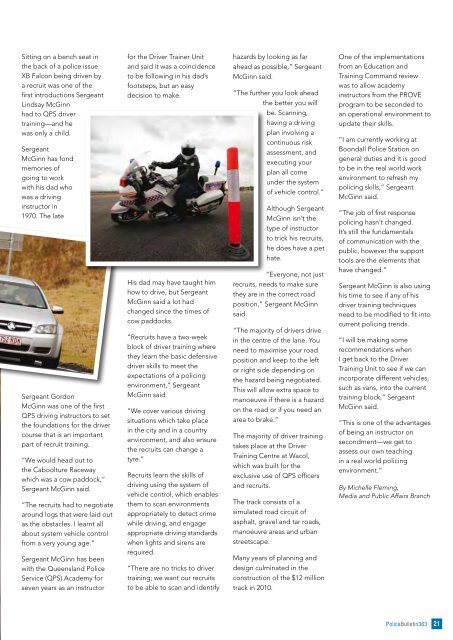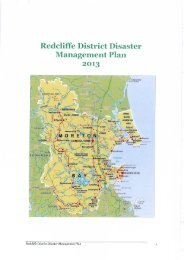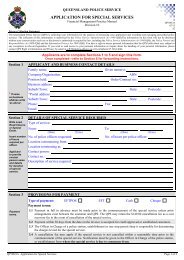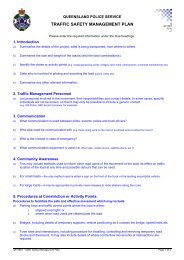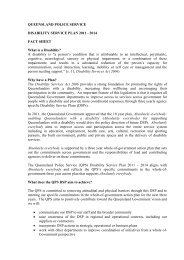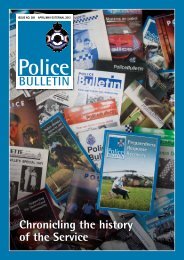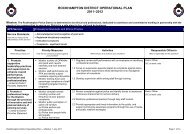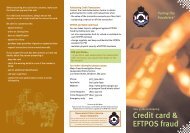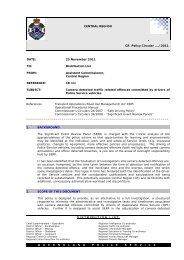Training Command - Queensland Police Service - Queensland ...
Training Command - Queensland Police Service - Queensland ...
Training Command - Queensland Police Service - Queensland ...
You also want an ePaper? Increase the reach of your titles
YUMPU automatically turns print PDFs into web optimized ePapers that Google loves.
Sitting on a bench seat in<br />
the back of a police issue<br />
XB Falcon being driven by<br />
a recruit was one of the<br />
first introductions Sergeant<br />
Lindsay McGinn<br />
had to QPS driver<br />
training—and he<br />
was only a child.<br />
Sergeant<br />
McGinn has fond<br />
memories of<br />
going to work<br />
with his dad who<br />
was a driving<br />
instructor in<br />
1970. The late<br />
Sergeant Gordon<br />
McGinn was one of the first<br />
QPS driving instructors to set<br />
the foundations for the driver<br />
course that is an important<br />
part of recruit training.<br />
“We would head out to<br />
the Caboolture Raceway<br />
which was a cow paddock,”<br />
Sergeant McGinn said.<br />
“The recruits had to negotiate<br />
around logs that were laid out<br />
as the obstacles. I learnt all<br />
about system vehicle control<br />
from a very young age.”<br />
Sergeant McGinn has been<br />
with the <strong>Queensland</strong> <strong>Police</strong><br />
<strong>Service</strong> (QPS) Academy for<br />
seven years as an instructor<br />
for the Driver Trainer Unit<br />
and said it was a coincidence<br />
to be following in his dad’s<br />
footsteps, but an easy<br />
decision to make.<br />
His dad may have taught him<br />
how to drive, but Sergeant<br />
McGinn said a lot had<br />
changed since the times of<br />
cow paddocks.<br />
“Recruits have a two-week<br />
block of driver training where<br />
they learn the basic defensive<br />
driver skills to meet the<br />
expectations of a policing<br />
environment,” Sergeant<br />
McGinn said.<br />
“We cover various driving<br />
situations which take place<br />
in the city and in a country<br />
environment, and also ensure<br />
the recruits can change a<br />
tyre.”<br />
Recruits learn the skills of<br />
driving using the system of<br />
vehicle control, which enables<br />
them to scan environments<br />
appropriately to detect crime<br />
while driving, and engage<br />
appropriate driving standards<br />
when lights and sirens are<br />
required.<br />
“There are no tricks to driver<br />
training; we want our recruits<br />
to be able to scan and identify<br />
hazards by looking as far<br />
ahead as possible,” Sergeant<br />
McGinn said.<br />
“The further you look ahead<br />
the better you will<br />
be. Scanning,<br />
having a driving<br />
plan involving a<br />
continuous risk<br />
assessment, and<br />
executing your<br />
plan all come<br />
under the system<br />
of vehicle control.”<br />
Although Sergeant<br />
McGinn isn’t the<br />
type of instructor<br />
to trick his recruits,<br />
he does have a pet<br />
hate.<br />
“Everyone, not just<br />
recruits, needs to make sure<br />
they are in the correct road<br />
position,” Sergeant McGinn<br />
said.<br />
“The majority of drivers drive<br />
in the centre of the lane. You<br />
need to maximise your road<br />
position and keep to the left<br />
or right side depending on<br />
the hazard being negotiated.<br />
This will allow extra space to<br />
manoeuvre if there is a hazard<br />
on the road or if you need an<br />
area to brake.”<br />
The majority of driver training<br />
takes place at the Driver<br />
<strong>Training</strong> Centre at Wacol,<br />
which was built for the<br />
exclusive use of QPS officers<br />
and recruits.<br />
The track consists of a<br />
simulated road circuit of<br />
asphalt, gravel and tar roads,<br />
manoeuvre areas and urban<br />
streetscape.<br />
Many years of planning and<br />
design culminated in the<br />
construction of the $12 million<br />
track in 2010.<br />
One of the implementations<br />
from an Education and<br />
<strong>Training</strong> <strong>Command</strong> review<br />
was to allow academy<br />
instructors from the PROVE<br />
program to be seconded to<br />
an operational environment to<br />
update their skills.<br />
“I am currently working at<br />
Boondall <strong>Police</strong> Station on<br />
general duties and it is good<br />
to be in the real world work<br />
environment to refresh my<br />
policing skills,” Sergeant<br />
McGinn said.<br />
“The job of first response<br />
policing hasn’t changed.<br />
It’s still the fundamentals<br />
of communication with the<br />
public, however the support<br />
tools are the elements that<br />
have changed.”<br />
Sergeant McGinn is also using<br />
his time to see if any of his<br />
driver training techniques<br />
need to be modified to fit into<br />
current policing trends.<br />
“I will be making some<br />
recommendations when<br />
I get back to the Driver<br />
<strong>Training</strong> Unit to see if we can<br />
incorporate different vehicles,<br />
such as vans, into the current<br />
training block,” Sergeant<br />
McGinn said.<br />
“This is one of the advantages<br />
of being an instructor on<br />
secondment—we get to<br />
assess our own teaching<br />
in a real world policing<br />
environment.”<br />
By Michelle Fleming,<br />
Media and Public Affairs Branch<br />
<strong>Police</strong>Bulletin363 21


